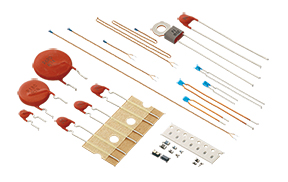Thermostat and thermistor
 A thermostat and thermistor are two ways to use metal and its reactions to temperature to read and report temperature changes. Metals of different types, especially copper, tungsten and aluminum, change certain properties as they become hotter or colder. The changes can be used to measure how temperature changes. As the metals change properties, such as their conductivity to electricity, the result is a reliable guide to how temperature changes. Both methods of measuring use metals and their properties relative to temperature, though in different ways.
A thermostat and thermistor are two ways to use metal and its reactions to temperature to read and report temperature changes. Metals of different types, especially copper, tungsten and aluminum, change certain properties as they become hotter or colder. The changes can be used to measure how temperature changes. As the metals change properties, such as their conductivity to electricity, the result is a reliable guide to how temperature changes. Both methods of measuring use metals and their properties relative to temperature, though in different ways.
Thermistors
A thermistor is an element with an electrical resistance that changes in response to temperature. This name is derived from the more descriptive term "thermally sensitive resistor," the original name for these devices. Thermistors were first discovered by Michael Faraday in 1833. They're now widely used in a variety of electronic applications, most often as temperature sensors. Additional uses of thermistors include current limiters, current protectors and heating elements.There are two kinds of of thermistors, NTC (negative temperature coefficient) and PTC (positive temperature coefficient). In general, you will see NTC sensors used for temperature measurement. PTC's are often used as resettable fuses - an increase in temperature increases the resistance which means that as more current passes thru them, they heat up and 'choke back' the current, quite handy for protecting circuits!
NTC (Negative Temperature Coefficient) whose resistance drops when the temperature increases
PTC (Positive Temperature Coefficient) whose resistance rises when the temperature increases
NTC Thermistors - These are generally used for temperature measurement as their RT (Resistance - Temperature) characteristic is well defined and can be readily programmed. NTCs are highly stable, low-cost and very accurate hence they are used in a large number of temperature sensors found in the home appliance, automotive and office automation markets.
Some larger NTC disc thermistors are used for current inrush limiting as they offer a neat and cost-effective solution to surge currents arising from switching on certain electronic and electrical products, e.g. S.M.P.S.s (Switch Mode Power Supplies), LED driver circuits or halogen lamps.
PTC Thermistors - These are generally used as solid-state fuses or thermal switches because near their transition point (curie point), the resistance increases rapidly by several orders of magnitude over a small change in temperature. This allows them to be easily incorporated into electronic circuitry and in the case of motor protection thermistors, allows several to be used in series to protect each phase of a 3-phase motor.
Thermistors are available at IBS Electronics from industry leading manufacturers. IBS Electronics is a distributor for many NTC thermistor manufacturers including Ametherm, Amphenol, AVX, EPCOS, Honeywell, Murata, Vishay & more.
Authorize Line: (*)
- Ametherm*
- Ampron*
- Asahi*
- Betatherm*
- Cantherm
- Microtherm
- Maida*
- Selco*
***************************
- Airpax
- Ametherm*
- IBS
- GE Sensing
- Keystone Carbon Co.
- NEC / Tokin
- Rodan
- RTI Surge *
- Stetron International Inc.
- Therm-O-Disc
- Thermometrics
- Tokin